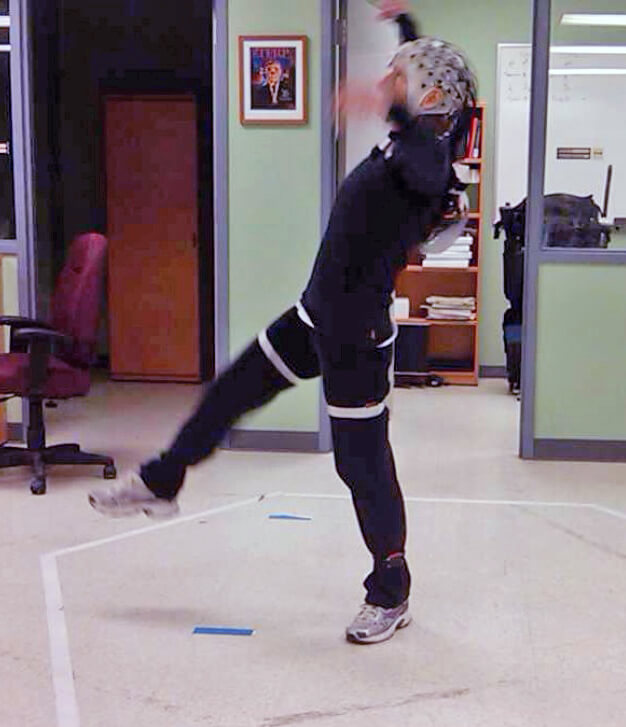- April 29, 2014
- By David Kohn
Neuroscientists haven’t really explored how movement and thought interact, largely because it’s hard for anyone to leap, twist and turn while lying flat in an MRI tube, or connected to a tangle of wires. But with the help of new mobile brain imaging technology, a Maryland researcher now has the beginnings of an answer.
Karen Bradley, an associate professor in the School of Theatre, Dance, and Performance Studies, and University of Houston neuroscientist Jose Contreras-Vidal, formerly an associate professor of kinesiology at Maryland, analyzed dancers’ brain signals as they thought about dancing and as they performed. They wore lightweight wireless sensors on their scalps in order to move unimpeded. The study is featured in the April issue of the journal Frontiers in Human Neuroscience.
The researchers found that dancers use multiple parts of the brain simultaneously, including those involved in higher-order decision-making, as well as parts that play a role in controlling and planning movement. “This gives us a fantastic glimpse into how dancers think when they express themselves,” says Bradley.

The study examined five experienced dancers who were asked to perform three activities: moving without a specific intention; thinking about dancing in a way that would convey a specific quality, such as lightness, or strength; and actually dancing in a way that would convey the particular quality. Bradley and Contreras-Vidal recorded the dancers’ brain activity during these three states, and found it was different in each case.
In the first state, moving without intention, the most active brain area was the sensory motor network, the regions in charge of “automatic” movements such as walking or talking, which typically require little or no conscious thought. In the second state, thinking about expressive dance, the most active regions were the prefrontal cortex and other areas involved in planning and decision-making. In the third state, both the thinking and the sensory-movement networks were active.
“I have never seen a study like this before. It’s a completely new approach,” says Klaus Gramann, a professor of biological psychology at the Berlin Institute of Technology. “It really highlights what we can do with mobile brain-body imaging. It was a very fruitful collaboration.”
One of the dancers moving as the scientists collect the data. Photo courtesy of Karen Bradley.

Gramann, a pioneer in the use of lightweight portable sensors to measure the brain, says the field has only been around for the past five or so years. Over that time, he says, neuroscientists have increasingly realized that movement has a profound effect on thought. “If we really want to understand how the brain works, we need to have subjects who move naturally,” he says. “Cognition is closely linked to movement and action.”
This is Bradley’s first work in neuroscience. She and Contreras-Vidal met in 2011, in a flamenco dance class, and realized they shared something besides a love of Spanish folk dancing. Both were deeply interested in understanding the complex links between movement, such as dance, and brain activity. They decided to collaborate on research, and continued to work together even after Contreras-Vidal was hired by the University of Houston.
Bradley has been dancing since the age of 8, and has worked as a professional dancer and choreographer. She’s now in charge of Maryland’s M.F.A. dance program, and also studies the history of dance. In addition, she works with a range of clients to improve their movement. She coaches business executives on speaking more effectively, and helps children with learning disabilities, teaching them physical strategies to improve their attention and focus.

“I’ve always been interested in how the body expresses emotions and ideas through movement,” she says.
Contreras-Vidal says the research sheds light on the broader question of how the brain turns electrical signals into movement. He’s now focusing most of his research on a different aspect of this issue: trying to design more effective neuro-prosthetics for people who are paralyzed or have lost limbs.
Both he and Bradley say their study shows how crucial thought is to dance. He says it could have implications for both dance and science. He suggested that it might be possible to create a performance in which the lighting and music adjust themselves in response to the brainwaves of the dancers. In addition, he says, it might eventually be possible to train dancers to better control their brain patterns, to help them express themselves in the most efficient and creative ways.
“It may be,” he says, “that being a top dancer might be connected to a particular brain pattern.”
Watch a dancer as she follows directions to express herself in a particular way.